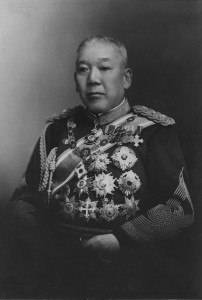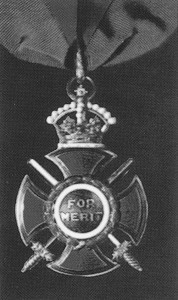The name Oyama was chosen by the suggestion of the mother of Post Master, Dr. W. H. Irvine. The post office was established in 1906 and required a name. At this time, news reports of Field Marshal Oyama Iwao’s military accomplishments from the Russo-Japanese War, 1904-1905, had been circulating in the newspapers and had caught the attention of Mrs. Irvine.
It was not just Mrs. Irvine who had read the papers and applauded the Japanese success in the war. In 1906, Prince Arthur of Connaught, along with several other appointees, including Lord Redesdale, were sent by King Edward VII to Japan to present the Emperor of Japan with the Order of the Garter as a sign of utmost friendship . The Prince also presented several other decorations to Japanese military figures, such as Marshal Oyama. Lord Redesdale narrates the presentation of the Order of Merit to Admiral Togo, Marshal Oyama, and Marshal Yamagata for their services in the Russo-Japanese war:
It was a grand sight to see these three bronzed and war-worn heroes come up one by one with bowed heads to receive at the young Prince’s hands an honour which was now for the first time conferred upon anybody not a subject of our King … It is a characteristic trait of the modesty of these great men that Admiral Togo certainly, and I think both the Marshals, at first wore their decorations with the words “For Merit” turned inwards. To wear them with such an inscription exposed would savour of bragging, and these men are no braggarts. It was only when the incorrectness of this was pointed out to them that, in deference to etiquette, they turned their badge the right way (Redesdale 1906:34-36).
Founded by Edward VII in 1902, the Order of Merit is “given to such persons as may have rendered exceptionally meritorious service in Our Crown Service or towards the advancement of the Arts, Learning, Literature and Science or such other exceptional service” (Duckers 2011:25). In this way, the popularity of Japan, and Marshal Oyama (who was later to be given the rank of Prince), was ensured throughout Britain and the Commonwealth.

Oyama Iwao led a remarkable career. Born in 1841 in Kagoshima, Oyama Iwao was the son of a samurai family. He passed away on December 10th 1916. Oyama Iwao was a protégé of Okubo Toshimichi, he worked to overthrow the Tokugawa Shogunate (who’s dynasty had been in power for 250 years), and therefore was a major player in the restoration in the Meiji. Later, Oyama served as a commander in chief of the Detached First Brigade during the Boshin War, and as commander serving with the Imperial Japanese Army’s artillery position, of which he was a founding member, on Mt. Oda at the Siege of Aizu, where he was wounded by Aizu guerillas, under the rule of Sagawa Kanbei.
In 1870, Oyama spent time in France, where he attended the École Speciale Militaire de Saint-Cyr, and was an official Japanese military observer to the Franco-Prussian War. He also spent three years in Geneva studying foreign languages and became a fluent speaker of Russian. Following his promotion to major general in the mid 1870’s, Oyama Iwao returned to France where he studied with Kawakami Soroku. On his return to Japan Oyama Iwao was instrumental in the establishing of the fledgling Imperial Japanese Army, which later went on to suppress the Satsuma Rebellion. During the Sino-Japanese War, he was appointed Commander-in-Chief of the 2nd Japanese Army, and was later successful in capturing the fortress of Weihaiwei.

Three years later Oyama Iwao received the title of Marquis for his services with the 2nd Japanese Army and later was given the title of Field-Marshall. During the Russo-Japanese War of 1904-1905 Oyama was named Commander-in-Chief of the Japanese armies in Manchuria. After Japan’s victory, Emperor Meiji elevated Oyama Iwao to the rank of Koshaku (Duke), and in 1907 gave him the title of Prince. In Japan, the title “Prince” does not necessarily denote a familial relation to the Emperor; rather it can be given to such individuals who have provided extraordinary services to their country.
Oyama Iwao was not only a great military figure and politician, but a highly educated man who spoke and wrote several European languages fluently. He was also said to be a great admirer of European style architecture, and actually built a house in Tokyo modelled after a German castle. It was said that his wife did not like the design and insisted that the children’s rooms be modelled in traditional Japanese style. Oyama’s European castle was destroyed by American air raids during World War II.
A statue of Japan’s famous General Oyama Iwao stands in the park at Kudanzaka in Tokyo, and his name lives on in Lake Country, British Columbia. Ironically, Prince Oyama Iwao never ever set foot in Canada. His name was chosen simply by what was written about him in the early news media, which is where Mrs. Irving learned of his many achievements while he served with the Japanese military.
This article was written by Mark Gill, assistant curator at the Lake Country Museum during the summer of 2014.
For additional information on this website about Oyama Iwao click here.
References:
Duckers, Peter (2011) British Orders and Decorations. Oxford: Shire Library.
Lake Country Museum Archives PF007.039
Lake Country Road Reports (2012) Oyama Road.
Lord Redesdale (1906) The Garter Mission to Japan. London: Macmillan.
Wikipedia (2014) Oyama Iwao. http://en.wikipedia.org/wiki/Oyama_Iwao







ava
i found this helpful
thanks!
ava
i found this helpful and interesting
thanks!